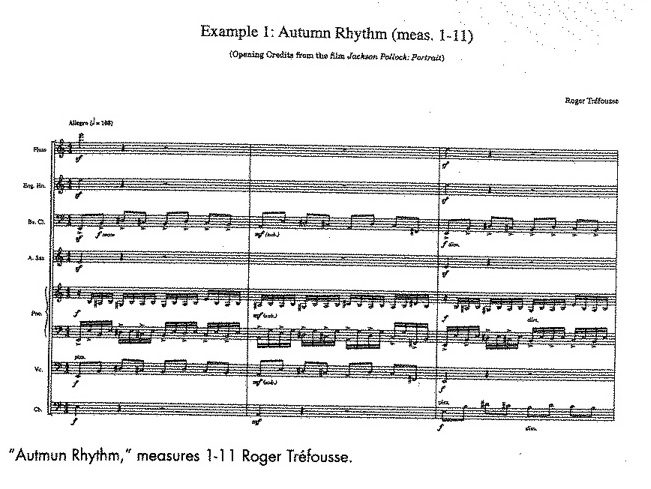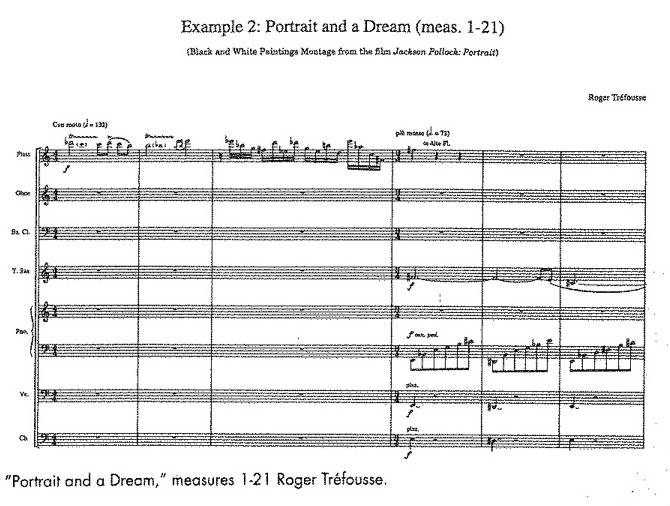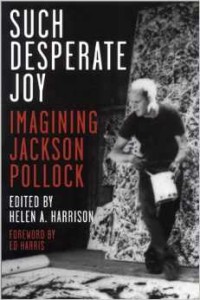When the director Amanda Pope asked me to write music for her PBS film Jackson Pollock:Portrait, I was probably as nervous as Pollock had been when asked to create his huge mural for Peggy Guggenheim’s front hallway. This would be a very different task from my work on other films. Normally, after looking at a film, I would write some music and listen to how it related to the aims and dramatic vision of the director. After more discussion, and, usually, several more musical sketches, we’d reach a common ground between our ideas and I’d go to work on the score.
In this case, however, there was another presence, that of the artist himself. Mpst of the music for this film would accompany images of Pollock’s painting, and I wanted to come up with a musical response to the painting before even looking at the film. I had a copy of the opulent catalogue from the Pollock show at the Beauborg and began looking at it carefully.
Now I began to see a way to connect musically with the full range of Pollock’s work. While I had no wish to mimic the canvases in any literal sense, I wanted to create a music for these paintings that would closely mirror their gesture and passion. I had seen the 1950 Hans Namuth film of Pollock painting, with its score by Pollock’s contemporary, the composer Morton Feldman. Like Pollock, Feldman was a pioneer in the kind of abstract thinking that burst forth in the 1940s and 1950s in New York. Feldman’s music has an astounding intensity of line, something it shares with Pollock, but I felt that the relation between the two artists stopped there. Feldman’s music for the film, like all of his work, is spare, quiet, delicate in the extreme, while Pollock’s work is dense, made from huge, sweeping gesture, and overlapping, conflicting thought,
 I write a piece full of counterpoint and energy and sweep, with an underlying sense of conflict. Different themes and emotions come together in a whole, but never quite mesh, and underlying tension holding them together and at the same time struggling to break them apart. Listing to my rendition of the piece (on the piano at this point), Amanda was unhappy with its effect. She felt that Pollock’s work was still fairly inaccessible to a general audience, and wanted the music to stress the lyrical, gorgeous quality of his work.
I write a piece full of counterpoint and energy and sweep, with an underlying sense of conflict. Different themes and emotions come together in a whole, but never quite mesh, and underlying tension holding them together and at the same time struggling to break them apart. Listing to my rendition of the piece (on the piano at this point), Amanda was unhappy with its effect. She felt that Pollock’s work was still fairly inaccessible to a general audience, and wanted the music to stress the lyrical, gorgeous quality of his work.
This brought me up short. Weeks of studying and thinking about Pollock’s art had me convinced that I had created a music that honestly reflected the paintings, and I wasn’t sure that I could change my thinking so radically. But I wasn’t only writing music about a Pollock painting. The task at hand was composing a score which also supported the director’s ideas about the artist and his work.
The crucial piece of music was the opening credits, a montage of Pollock’s all-over paintings. I had spent time on the east end of Long Island, where I now live, where Pollock painted these breakthrough canvases, and there was no question in my mind that that landscape, the light and the colors, were reflected in these paintings. Looking out over Accabonac creek, with the spring trees in bloom and the intense blue sky above them, it was certainly possible to see these canvases almost as a kind of abstract impressionism. For the opening creits, at least, the darker, note ambiguous aspect could be put aside.
I kept the energy and dense counterpoint of my earlier effort, but added a clearer tonal center, and made the orchestration and texture of the music glitter with a sense of light and color that the landscape, and the paintings, certainly possess. (see Example 1).
My original sketches came into the film as well, as accompaniment to the black and white paintings, Pollock’s last important work before he began the downward spiral to the tragic end of his life in 1956 (see Example 2). These paintings still possess a strong, lyrical energy, but it is here where one most strongly feels the existential despair as well. The all-over paintings are much more optimistic, and deserved a music which reelected that life-affirming energy.
I later made a suite of music from the film, which has become one of my most-performed works. Both the pieces I’ve discussed are incorporated into the suite, reflecting Pollock’s energy and vision in all its shades of light and darkness.
################################
This article was originally printed in the book “Such Desperate Joy – Imagining Jackson Pollock” Edited by Helen A Harrison.
You can check out the book or purchase it on Amazon by CLICKING HERE


